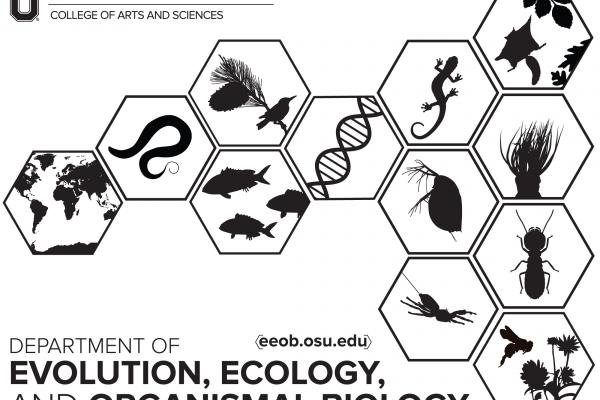Publications by EEOB faculty April 1 - April 30

Phylogenomics in Asarum section Hexastylis: serial innovations in floral form spawned from two geographically-widespread species.
Brandon T. Sinn, Christina Daragan, John V. Freudenstein, Craig F. Barrett. 2018. Proceedings of the West Virginia Academy of Science. Vol 90, No 1.
Abstract
Asarum section Hexastylis (Aristolochiaceae), is a group of flowering plants endemic to the southeastern United States whose variable floral morphologies and overlapping distributions have long caused taxonomic confusion. Individual species distributions range from the entirety of the southeastern US to only a single gorge. The flowers of section Hexastylis species, to various degrees, appear to have converged on a basidiomycete-like morphology and are putatively pollinated by fungus gnats. Earlier attempts to resolve species boundaries and the evolution of floral traits in the group with commonly-used phylogenetic markers have largely been uninformative at the lowest taxonomic levels.
To uncover species-level relationships, we sequenced thousands of regions dispersed throughout the nuclear genome using Double-Digestion Restriction Enzyme-Associated DNA Sequencing. Data matrices were assembled using the Pyrad pipeline. Phylogenomic inference was conducted under both maximum likelihood and coalescent frameworks. Sequencing was conducted for 97 individuals, representing all taxa in section Hexastyles.
Phylogenomic inference recover two major diversification events within section Hexastylis. Phyletic grades of a geographically-widespread, paraphyletic progenitor species have repeatedly spawned geographically-restricted derivative species with novel floral shapes. Recovered phylogenetic relationships evidence parallel evolution of similar calyx tube shapes, suggesting the operation of geographically partitioned adaptive pressures, most likely associated with fungus gnat pollination.
Molecular mechanisms underlying intraspecific variation in snake venom
Abstract
Abstract
Social parasites exploit resources of other social species, to the detriment of their host. In order to enter and integrate in a host colony, social parasites must avoid being detected as a non-nestmate. The parasites, therefore, use one or a combination of chemical strategies: (1) producing recognition cues that match host's (mimicry), (2) acquiring recognition cues from the hosts or its nest (camouflage), (3) not producing recognition cues (insignificance) and/or (4) using substances for confusing, suppressing or appeasing the host (weaponry). In this study, we investigate the integration strategy of Megalomyrmex symmetochus ants into colonies of the fungus-growing ant Sericomyrmex amabilis. We compared the chemical odour profiles of parasitized and nonparasitized S. amabilis colonies with the profiles of the parasites. Additionally, we conducted behavioural assays, where we introduced a single ant, being either a nestmate, a conspecific non-nestmate or a parasite into an arena with five S. amabilis workers and scored the behaviour of the latter ants. The chemical analysis revealed that the social parasites have distinct odour profiles and share only one hydrocarbon with its host, have a low overall abundance of cuticular hydrocarbons and have high concentrations of venom-derived alkaloids. In behavioural experiments, we found that workers of nonparasitized colonies fight against parasite intruders, whereas workers of parasitized colonies treat introduced parasites (from their own and from another parasitized colony) similar to their conspecific nestmates. All workers (parasitized or not) show more submissive behaviour towards parasitized workers and parasites than towards nonparasitized workers. The chemical analysis of odour profiles suggests that the parasites use a chemical insignificance strategy. Furthermore, the chemical and behavioural data suggest that the parasites use weaponry to maintain an amiable association with their host ants. We discuss the biological significance of the lack of aggression in S. amabilis workers from parasitized colonies.
Intragroup social dynamics vary with the presence of neighbors in a cooperatively breeding fish
Abstract
Effect of hypoxia on diet of Atlantic bumper Chloroscombrus chrysurus in the northern Gulf of Mexico
Cassandra N. Glaspie, Melissa Clouse, Aaron T. Adamack, YoonKyung Cha, Stuart A. Ludsin, Doran M. Mason, Michael R. Roman, Craig A. Stow, Stephen B. Brandt. 2018. Transactions of the American Fisheries Society. https://doi.org/10.1002/tafs.10063Abstract
Cultural eutrophication is a global problem that often leads to hypoxic conditions in coastal systems. While improving, our understanding of the impacts of hypoxia on trophic interactions in pelagic and bentho‐pelagic food webs is limited. Toward this end, we evaluated diet composition and mass‐specific consumption of Atlantic bumper Chloroscombrus chrysurus, a numerically dominant planktivorous fish in the northern Gulf of Mexico, relative to dissolved oxygen concentration and fish size. Atlantic bumper catch per unit effort (CPUE) was similar in hypoxic and normoxic areas. Mean mass‐specific consumption of small Atlantic bumper in hypoxic areas was greater than that of both small and large individuals in normoxic areas. The most commonly ingested prey type for both large and small Atlantic bumper was shrimp larvae. Large quantities of fish larvae were consumed by adult Atlantic bumper in hypoxic regions. These findings demonstrate that hypoxia can alter feeding of dominant fishes in the northern Gulf of Mexico, which may influence energy flow in the region.
